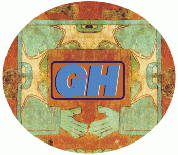
MEANING OF THE LOGO

Located close to Puebla land about 80 miles east of Mexico City are
the Cacaxtla ruins, discovered in 1975 by treasure hunters. This prehispanic
site, whose murals are considered among the most beautiful of any archeological
site in Mexico, probably reached its apogee between 700 and 900 AD, after
the decline of Teotihuacan. The dynamic composition, realism of the scenes,
harmonic proportions, expressive gestures, and other stylistic figures
denote a strong influence of the Mayan and Tehotihuacan cultures on the
mural paintings. The Mayan calendar was of great religious importance and
provided the basis for the development of Mayan astronomy. It is thus common
to find in Cacaxtla, as well as in other major prehispanic sites with Mayan
influence, such as Tehotihuacan or Xochicalco, some representations related
to cosmogony and mythology. In the south Mural located in the A building
in Cacaxtla (believed to be dedicated to venus and rain), we find the symbol
that is chosen as the logo for the Guillermo Haro International Program
on Advanced Astrophysical Research.
DESCRIPTION
In Building A (South Mural), in front of the face of a feathered man
standing over a snake, is a blue hollow rectangle open at its bottom side
with two hands. It has been chosen for the GH logo. The other three sides
of the rectangle look like arms and contain eyed half stars in white. The
rectangle is encircled by alternating eight left and right human footprints
representing motion. A "feathered eye" glyph is depicted in front of this
element.
INTERPRETATION
The inner rectangle symbolizes the terrestrial level, protected by the sky (arms) and the hands denote giving. The 3 half white stars with the stellar eye symbolize Venus. The 8 human footprints represent the 8 days during which the planet is invisible until it shows up again as the morning star.
Venus as the Morning Star is referred to as feminine, but as the Evening
Star it is referred to as masculine. Both male and female representations
of Venus (Tlahuizcalpantecuhtli) are very common in Cacaxtla because of
the Cacaxtlan inhabitants' knowledge of its 584 day cycle (8 invisible
days before the 250 visible days as the evening star, 90 invisible days
before the 236 visible days as the Morning Star).